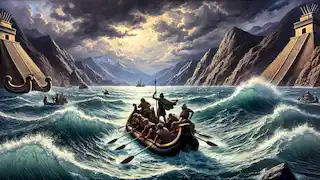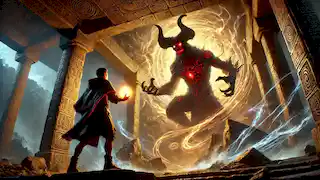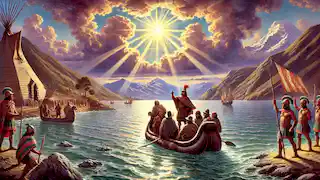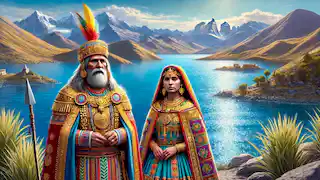The shimmering waters of Lake Titicaca, the highest navigable lake in the world, straddle the borders of Peru and Bolivia, resting at an elevation of over 12,500 feet. The lake has been a sacred site for centuries, rich with myths and legends that speak of gods, heroes, and the birth of civilizations. Among the most ancient and revered stories is "The Legend of Lake Titicaca," a tale of creation, struggle, and divine intervention that shaped the peoples and cultures of this mystical land. Let us embark on a journey through time, where gods walked the earth and the fates of nations hung in the balance. Long ago, before the Incas rose to power and before humanity had tamed the lands, the world was a realm of darkness. The sun had yet to rise, and the earth was a barren wasteland, devoid of life. The creator god, Viracocha, watched from the heavens, knowing it was time to bring light and life to the world. Viracocha descended to earth, choosing a place by the shores of the great lake, which would one day be known as Titicaca. He gazed across the water, shimmering even in the faint starlight that dotted the skies, and saw the potential for creation. With a wave of his hand, Viracocha commanded the mountains to rise from the earth, their jagged peaks scraping the heavens. Rivers carved through the valleys, and plants began to bloom. Animals roamed the newly formed land, but still, something was missing. Viracocha knew that life needed more than just animals and plants to flourish. He reached into the depths of the earth and shaped the first humans from clay. These beings were simple, primitive creatures, who wandered aimlessly across the lands. They did not understand the world around them, nor did they know how to harness its power. Viracocha saw this and realized that they needed guidance. From the waters of Lake Titicaca, Viracocha summoned two divine children, Manco Cápac and Mama Ocllo. They were born of the lake's sacred waters, their divine lineage making them wise and strong. Viracocha charged them with a great mission: to teach the humans how to cultivate the land, build cities, and create a thriving civilization. Manco Cápac and Mama Ocllo set off from the lake, traveling far and wide, spreading knowledge and wisdom. Manco Cápac and Mama Ocllo traveled for many days, crossing mountains and rivers, until they arrived in the valley that would one day become the city of Cusco. It was here, in the heart of the Andean mountains, that they decided to establish their kingdom. Manco Cápac struck the earth with his golden staff, which sank deep into the ground, a sign that this was the place chosen by the gods. They began to teach the people of the valley how to farm, introducing crops like maize and potatoes that would sustain them for generations. They taught them how to build sturdy homes from stone, and soon a grand city began to rise. Manco Cápac became the first Sapa Inca, the emperor of the new civilization, while Mama Ocllo became the priestess, teaching the women how to weave and nurture their families. Their kingdom, known as the Kingdom of the Sun, grew in power and prosperity, with the blessings of Viracocha watching over them. The people worshiped Inti, the god of the sun, believing that Manco Cápac and Mama Ocllo were his children, sent to guide them. Cusco became a center of worship and power, a city where the sun god's light always seemed to shine brightest. However, the peace and prosperity that Manco Cápac and Mama Ocllo had worked so hard to create would not last forever. Dark forces, jealous of the power that had grown in the heart of the Andes, began to stir beneath the surface of the earth. In the depths of the earth, far beneath the mountains, lived Supay, the god of death and ruler of the underworld. Supay had watched in envy as Viracocha created the world and as Manco Cápac and Mama Ocllo built a prosperous kingdom. He despised the light and the life that flourished on the surface, for his realm was one of darkness and decay. Supay decided it was time to reclaim the world for himself. He began to send forth his minions, the evil spirits and demons of the underworld, to sow discord among the people of the Andes. Crops began to fail, and strange illnesses swept through the villages. The once-bright sun seemed to dim, and the people grew afraid. Manco Cápac, seeing the suffering of his people, prayed to Viracocha for guidance. The creator god appeared to him in a vision, warning him of Supay's plan to plunge the world into eternal darkness. Viracocha told Manco Cápac that the only way to defeat Supay was to travel to the heart of Lake Titicaca, where a sacred temple lay hidden beneath the waters. Inside this temple was the Sunstone, a powerful relic that could banish Supay back to the underworld. Determined to save his people, Manco Cápac set out on a perilous journey back to Lake Titicaca. He was accompanied by a group of loyal warriors and priests, all of whom understood the gravity of their mission. As they traveled, they encountered many dangers. Supay's minions stalked them through the mountains, and strange creatures lurked in the shadows, waiting to strike. The journey was long and arduous, and many of Manco Cápac's companions fell along the way. But he pressed on, driven by his love for his people and his determination to defeat Supay. Finally, after many days of travel, they reached the shores of Lake Titicaca. The lake was vast and calm, its waters reflecting the sky like a mirror. But Manco Cápac knew that beneath its serene surface lay the temple that held the key to their salvation. He and his remaining companions boarded a small raft and began to row toward the center of the lake. As they approached the center, the waters began to churn, and a great storm arose. The wind howled, and the waves crashed against their small raft. It was as though the lake itself was trying to prevent them from reaching their destination. But Manco Cápac would not be deterred. He called upon the power of Inti, and the storm began to calm. Suddenly, the waters parted, revealing a stone staircase that descended deep into the lake. Manco Cápac and his companions left their raft and began to descend the stairs, plunging into the depths of the lake. At the bottom of the stairs, they found the Sunken Temple, a grand structure made of stone and adorned with golden decorations that shimmered even in the dim light of the lake's depths. At the center of the temple was the Sunstone, a large, glowing gem that radiated warmth and light. As Manco Cápac approached the Sunstone, the ground began to shake, and a deep, menacing voice echoed through the temple. Supay had arrived. The god of the underworld emerged from the shadows, his form shifting and monstrous. His eyes burned with hatred as he faced Manco Cápac. Supay laughed, mocking the Inca's attempts to stop him. "You cannot defeat me, mortal," Supay snarled. "The world will soon be mine, and your precious sun will be extinguished forever." Manco Cápac, undeterred, reached for the Sunstone. As his hand touched the stone, a burst of light filled the temple, driving back the darkness. Supay screamed in fury, lashing out with his dark magic, but the power of the Sunstone protected Manco Cápac and his companions. A great battle ensued, with Manco Cápac wielding the power of the Sunstone against Supay's dark forces. The temple shook with the force of their clash, and the waters of the lake churned above them. But Manco Cápac was strong, and the light of the Sunstone grew brighter with each passing moment. Finally, with a mighty strike, Manco Cápac banished Supay back to the underworld. The god of death let out a final, anguished scream as he was consumed by the light, and the darkness that had plagued the land began to lift. With Supay defeated, Manco Cápac and his companions returned to the surface of the lake. As they emerged from the water, the sun broke through the clouds, shining brighter than ever before. The people of the Andes, who had been watching the skies in fear, rejoiced at the return of the sun's warmth and light. Manco Cápac returned to Cusco, where he was hailed as a hero. Under his continued rule, the Kingdom of the Sun flourished once more. The crops grew strong, the people were healthy, and the sun shone brightly over the land. Manco Cápac and Mama Ocllo continued to guide their people, ensuring that the wisdom of the gods was passed down through the generations. As time passed, the story of Manco Cápac's journey to Lake Titicaca and his battle with Supay became legend, told around fires and passed down from parent to child. The lake remained a sacred site, a place where the gods had once walked and where the fate of the world had been decided. Even today, the people of Peru and Bolivia look to Lake Titicaca with reverence, knowing that within its depths lies the memory of a great battle between light and darkness, and the courage of a hero who saved the world.The Dawn of Creation
The Kingdom of the Sun

The Rise of Supay

The Journey to the Sunken Temple
The Battle of the Sunstone

The Return of the Sun

The Legend of Lake Titicaca
Reading Time: 9 min

About Story: The Legend of Lake Titicaca is a Legend Stories from peru set in the Ancient Stories. This Dramatic Stories tale explores themes of Good vs. Evil Stories and is suitable for All Ages Stories. It offers Cultural Stories insights. A tale of gods, creation, and a hero's journey to save the world from darkness.
















